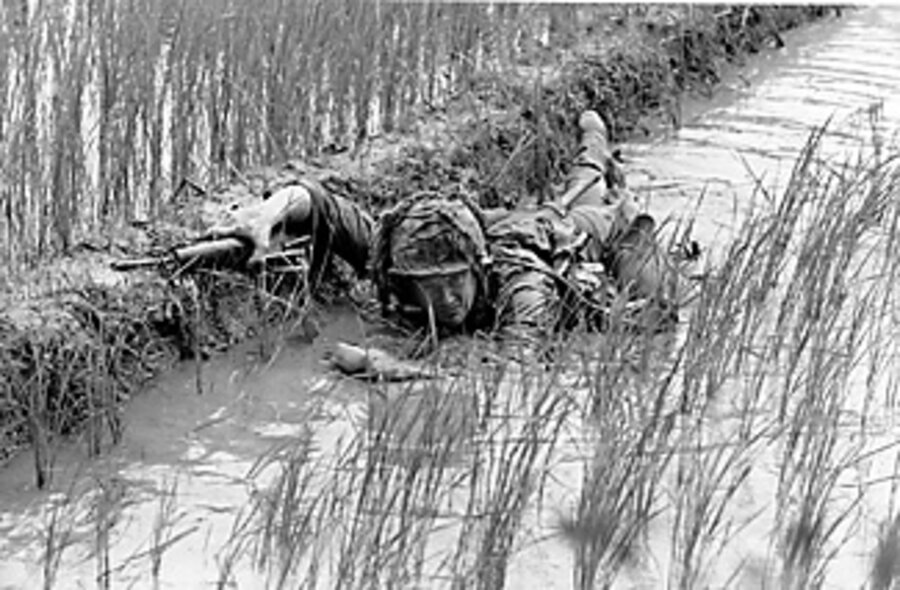Declassified study puts Vietnam events in new light
Loading...
| WASHINGTON
US signals intelligence – the much-vaunted ability of American military and spy units to eavesdrop on the radio calls and other electronic communications of an adversary – failed at crucial moments during the Vietnam War, according to a just-declassified National Security Agency history of the effort.
The 10,000 cryptographers and other signals personnel in Southeast Asia at the time did not predict the start of the Tet offensive on Jan. 31, 1968. Prior to that, signals intelligence may have actually misled President Johnson and other top policymakers about the nature of the 1964 Gulf of Tonkin incident, in which a supposed North Vietnamese attack on US forces triggered a major escalation in the war.
US eavesdroppers had many successes during the war, according to the lengthy document, particularly in picking up the tactical communications of North Vietnamese and Viet Cong fighters in the field.
But when it comes to major events, signals intelligence is not magic, as the history makes clear. That is a point current policymakers would do well to remember as they struggle to interpret intelligence dealing with the complex modern problems of nuclear proliferation and Islamist extremism.
In both the Tet and Gulf of Tonkin cases, "critical information was mishandled, misinterpreted, lost, or ignored," writes NSA historian Robert Hanyok in the agency history.
Yet both were major turning points of the Vietnam conflict. The Gulf of Tonkin led to open US involvement in the fighting. Tet, though a tactical military defeat for the North, was a surprise for a US public that had been led to believe victory might be imminent. It may have contributed to declining support for the American intervention.
The Gulf of Tonkin incident occurred in early August 1964. On Aug. 2, North Vietnamese patrol boats attacked a US destroyer, the USS Maddox, in the Gulf of Tonkin, an arm of the South China Sea off Vietnam's northeastern coast. Mr. Johnson warned the North that another such attack would bring "grave consequences." On Aug. 4, Johnson announced that another attack had occurred and asked Congress to vote him powers to respond. On Aug. 7, Congress gave him those powers in the Gulf of Tonkin resolution, which became the legal foundation for increased US involvement.
Even at the time, some doubted that the second attack had occurred. Yet the Johnson administration produced what seemed a key piece of evidence – a North Vietnamese Navy after-action report, intercepted by the NSA, which appeared to discuss the battle.
In fact, the intercept had been mistranslated, according to the just-released report. The Vietnamese word for "military operations" can also mean "long movement," and the intercept in reality referred to the towing of two North Vietnamese patrol boats some distance for repairs.
Furthermore, US intelligence intercepted no communications or radar emissions associated with the assumed attack. Mr. Hanyok, the NSA historian, cites Sherlock Holmes, who famously once solved a case because a dog did not bark, proving something did not occur.
"As Holmes would come to conclude that no crime was committed, so we must conclude that, since [signals intelligence] never intercepted anything associated with an attack, none ever occurred," Hanyok writes.
The Tet offensive erupted on Jan. 30, 1968, in which North Vietnamese forces and their Viet Cong allies attacked major cities in South Vietnam. The attack demoralized the US public and many of its political and military leaders. Just days earlier, US commander in chief Gen. William Westmoreland had assured them the enemy was largely beaten.
In terms of signals intelligence, Tet may have been an example of what intelligence analysts call the "Ultra problem," after the famous Ultra code breakers of World War II: the tendency of military and political leaders to look at electronic intercepts as gold, magic, and the keys to victory rolled into one.
At that period in the war, the overwhelming bulk of radio intercepts came from North Vietnamese army units operating in the demilitarized zone between the two countries, and the Central Highland region. Thus, that was where General Westmoreland focused his attention, and where he believed the next major attack would come.
Yet communist units in the South had learned radio discipline to hide their movements. US intelligence did pick up communications talking of an attack on Saigon and other cities, and even heard reference to an "N-day" of the offensive's launch.
But no one date was named as N-day. "The exact date remained unknown, and the other indicators were never fully realized in the NSA reporting," says the agency history.
Thus a major turning point in the war was not predicted in advance, at least by eavesdropping and other electronic means.
With both the Gulf of Tonkin and Tet "it is easy to see how ... crimped analytic capability, especially in cryptanalysis, and the lack of sufficient qualified linguists affected NSA reporting," concludes Hanyok.
The NSA history of signals intelligence during the Vietnam conflict, "Spartans in Darkness: American SIGINT and the Indochina War, 1945-1975" was written in 2002. It is posted on the website of the Federation of American Scientists Project on Government Secrecy.





